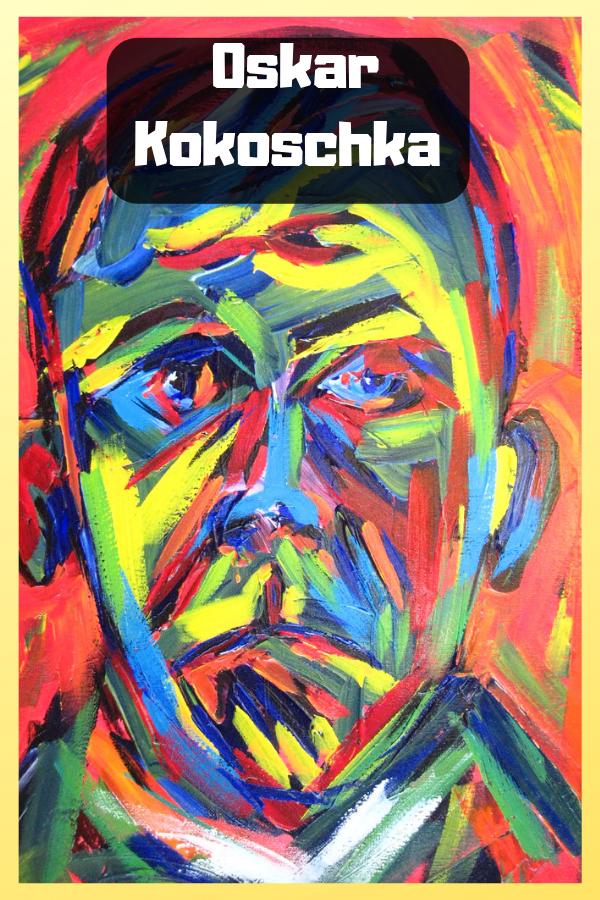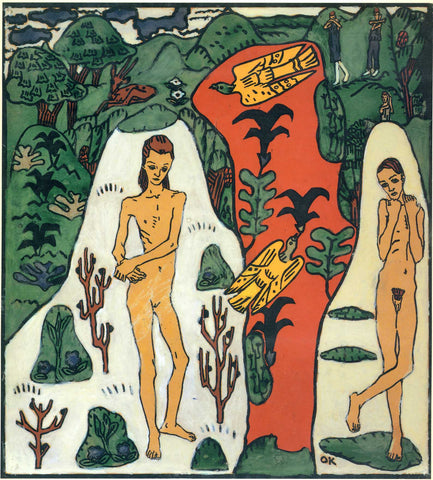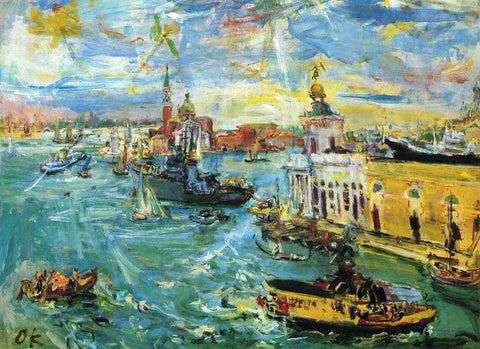Oskar Kokoschka Famous Paintings
Oskar Kokoschka Biography
On March 1st, 1886, Oskar Kokoschka was born in Pöchlarn, Austria. He spent the majority of his adolescence in Vienna, where in 1904 or 1905 he enrolled in the Kunstgewerbeschule.
He created fans and postcards while still a student for the Wiener Werkstätte, which released his debut collection of poetry in 1908.
Kokoschka was expelled from the Kunstgewerbeschule the same year after receiving harsh criticism for the pieces he displayed in the Vienna Kunstschau.
Adolf Loos, an architect, became aware of him at this point and became his most ardent supporter. Kokoschka wrote plays during this early time which are regarded as some of the earliest instances of expressionist drama.
In 1910, he held his first solo exhibition at the Galerie Paul Cassirer in Berlin. Later that year, he held a second solo exhibition at the Museum Folkwang in Essen. He also started writing for Herwarth Walden's magazine Der Sturm in 1910.
From 1910 to 1914, Kokoschka specialized in portraiture and split his time between Berlin and Vienna. He volunteered to serve on the eastern front in 1915, just as World War I was beginning, where he was severely wounded.
He relocated to Dresden in 1917 while he was still recovering, and in 1919 he accepted a chair at the Akademie there. Paul Westheim's thorough biography of the artist was released in 1918.
Across the 1920s and 1930s, Kokoschka traveled much in Europe, North Africa, and the Middle East.
He went back to Vienna in 1931 but moved to Prague in 1935 as a result of the Nazis gaining control. Two years later, he received Czechoslovak citizenship.
Thomas Garrigue Masaryk, the president of Czechoslovakia, was painted by Kokoschka in 1936, and the two men grew close. As "degenerate art," his creation was denounced by the Nazis in 1937, and it was hidden from view.
In 1938, the year of his first solo exhibition in the United States at the Buchholz Gallery in New York.
Two significant traveling exhibitions of Kokoschka's artwork began in Boston and Munich, respectively, in 1948 and 1950.
He established his Schule des Sehens at the Internationale Sommer Akademie für Bildenden Künste in Villeneuve, close to Geneva, where he had relocated.
In 1956, Kokoschka's collected writings were released, and at about this time, he started working on stage designs.
He received recognition in 1962 with a retrospective at the London-based Tate Gallery. Kokoschka passed away in Montreux, Switzerland, on February 22, 1980.
Oskar Kokoschka Artworks
Oskar Kokoschka Alma Mahler
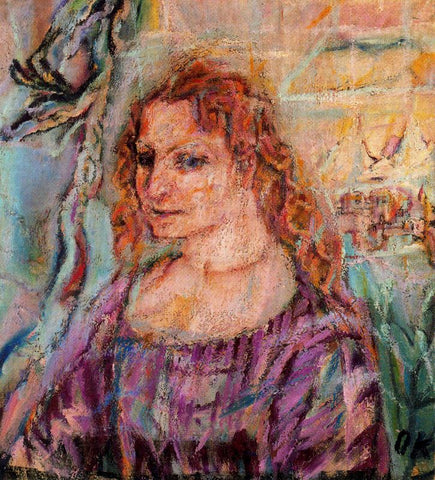
Alma Mahler commissioned Kokoschka to paint her portrait in April 1912, while they were getting to know one another.
She posed as a brand-new Gioconda for Kokoschka, who gave her the same enigmatic features that Leonardo gave his Mona Lisa.
He depicted the lovely young lady with long, flowing, tousled hair in a delicate, iridescent tint, strawberry blonde hair and blue eyes.
Alma thought of herself as Lucrezia Borgia, the stunning Renaissance princess who drew well-known painters to the Ferrarese court, including Ariost, and who rose to notoriety for her scandalous love life.
Buy Claude Monet Reproduction Of Fine Art Prints On Canvas
The Bride of the Wind or The Tempest by Oskar Kokoschka
Two lovers are depicted by Kokoschka in a melancholy embrace as they lie side by side in a frenzied, jittery brushstroke.
While the woman drifts off to sleep with her eyes gently closed and is blissfully ignorant of the reality that is looming larger and larger with each passing hour of the night, the man is awake.
He is depicted almost skeleton like with the way his deep-set eyes look into nothing, hollow cheekbones, hideous, twisted fingers, jutting chin, and taut skin covering his bones.
The abstract space between them is made up of swirls of black and dark blue, while their bodies are painted in rapid, tense strokes of white with dashes of yellow and blue.
The Dreaming Boys by Oskar Kokoschka
This is Kokoschka's significant graphic work. "Die traümenden Knaben" was created in response to a request for a children's book. The novel received a variety of responses, in part because of the sensual imagery.
Expressionism is anticipated by the use of stylization, warped figures, and a folk art aesthetic. Japanese woodcuts are another source of inspiration, as evidenced by the way Kokoschka employs flat swaths of vibrant color and black outlines.
Gustav Klimt, a well-known Austrian painter at the time had a great impact on Kokoschka, and received a dedication in the book from the author.
Top 15 Most Famous Paintings by Paul Cézanne
Venice Dogana by Oskar Kokoschka
Kokoschka and his wife visited Venice in the summer of 1948 in preparation for the Venice Biennale, where Kokoschka would present a number of his works.
He finished this breathtaking view of the San Marco Basin from his hotel room. In the composition's center lies the imposing San Giorgio Maggiore Church, and to the right is the Punta della Dogana, a former customs building that is now a museum.
The canal is populated by several vessels. While Kokoschka took great pride in his earlier rebellious status as a young Expressionist.
In this work we see him assimilating himself back into a rich tradition of European landscape painting that dates back to Canaletto, who painted Venice so masterfully.
In this landscape painting, Kokoschka maintains his use of vivid color and brief, vigorous brushstrokes.
Camille Pissarro Famous Paintings | Reproduction Of Fine Arts
Oskar Kokoschka Self-portrait

The exhibit of Degenerate "Art" put on by the Nazis to mock modern art featured eight of Kokoschka's paintings.
In reaction to his involvement in the show, the artist changed the pose of his arms in this picture to make him firmly crossed. The woodland behind the grandparents' home, where he started the painting, may be seen in the backdrop.
On the right, a deer, and on the left, a figure running. Both of these aspects may allude to escape or chase as well as the artist acting as a hunted man, according to some interpretations.
20 Famous Edgar Degas Paintings [Art Masterpieces]
Oskar Kokoschka self-portrait with hand by his face
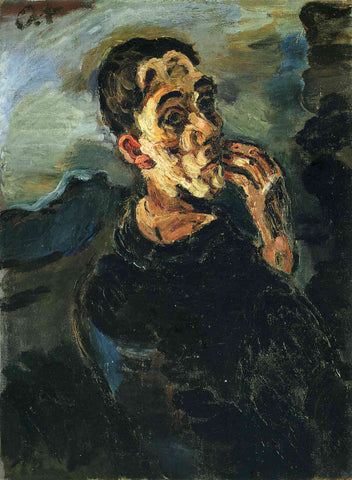
In the Saxon capital, where he had been awarded a position at the Academy of Fine Arts in 1919, he painted this impassioned self-portrait.
It is a depicted autobiographical account of Kokoschka's psychological condition during these formative years in Dresden, which were characterized by anxieties, internal strife, and unrest.
Kokoschka shows himself in an uneasy pose of detachment and tenderness with a questioning face features. In light of the catastrophic events of the First World War, the palm on the mouth seems to be a symbol of insecurity and bewilderment.
Oskar Kokoschka Prints
Sleeping Woman by Oskar Kokoschka

When Oskar Kokoschka was still a scholar at Vienna's Kunstgewerbeschule. Fritz Waerndorfer the main financial supporter of the Wiener Werkstätte Vienna's premier creative studio, asked him to create an illustrated fairy tale for his children.
Hence "Sleeping Woman," the young girl was created. She is surrounded by water and a stone wall, despite the fact that there are creatures in the image.
Two redfish lurk in the lake, two bluebirds lean on the side of the fortress, and a buck and a deer approach from the forest, all of which serve to accentuate the fact that she is alone. This all revolves around the tranquil and melancholic sleeping girl.
Red, blue, green, and yellow are the primary colors utilized by Kokoschka throughout the book. Each element in the drawing has a broad outline surrounded by black.
The collapsed sense of proportion emphasizes the sharply defined sections of black, white, and color that weave together a multicolor fabric of shape and design.
The sharp contours of the treetops and the long, flowing lines of the water create a contrast, while the harsh lines of the bricks harmonize with the softer shapes of the trees and flowers.
The young girl's body is totally made up of tiny colored squares, and certain shapes even appear to disintegrate into the background hue of black.
The decorative style that predominated in Vienna during the fin de siècle is typified by the stylized weaving in Kokoschka's lithographs.
His absorption of numerous "primitivist" tides in European art is evident in the cloisonné-like outlines, unusual viewpoint, and flat surfaces of color.
Famous Paintings By Diego Rivera [Top 20 Art Masterpieces]
The Sleepers by Oskar Kokoschka

Commissioned by Fritz Waerndorfe to create an illustrated fairy tale. Kokoschka presented a melancholy poem about teenage sexual discovery that was set on remote islands, far from the metropolitan area and the bourgeois lifestyle.
Diego Velazquez Famous Paintings [Top 20 Fine Art Masterpieces]
Albert Ehrenstein by Oskar Kokoschka
One of Kokoschka's most noteworthy portraits was the painting of Albert Ehrenstein, which aimed to portray the mind and feelings of Albert Ehrenstein.
Kokoschka adopted fresh stylistic advancement in his works by implementing quick brushstrokes that emphasized and reinforced key visual elements while fading the background colors.
Giorgio De Chirico Famous Artworks
If you like this article, please share it with others, so perhaps they can also enjoy it. Any of the artwork purchased on ATX Fine Arts really supports me as an artist, along with helping the site grow organically, thank you very much.

